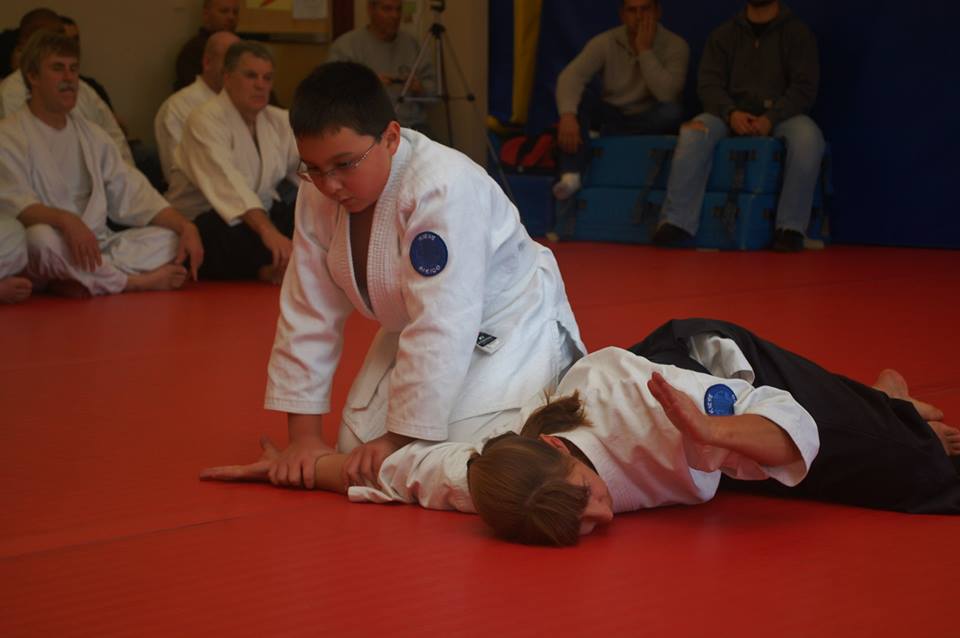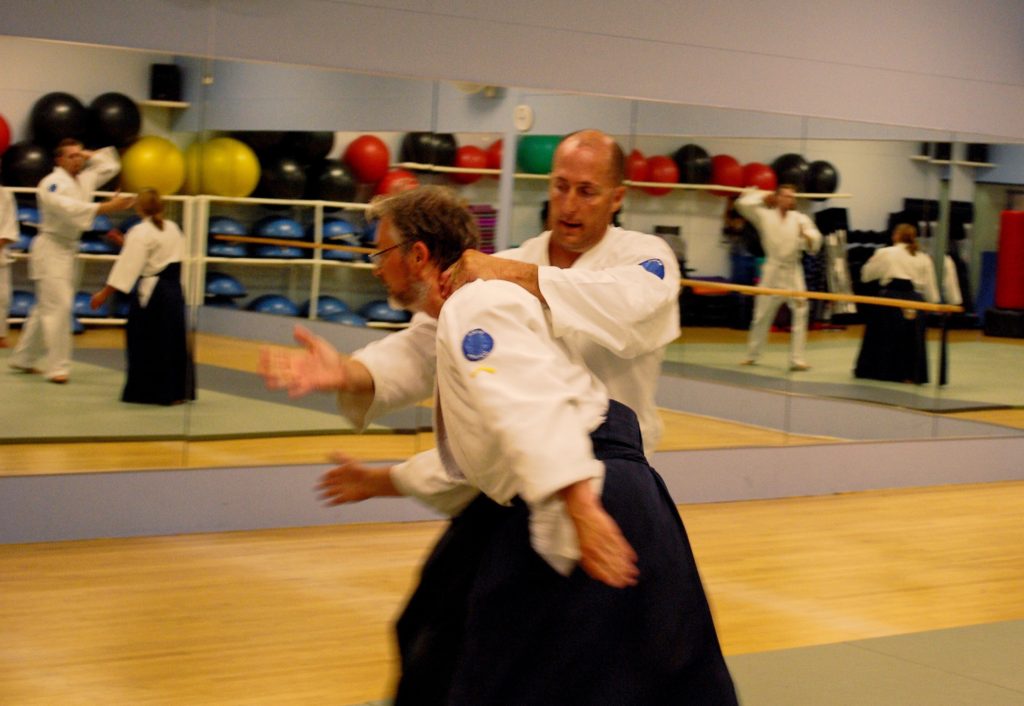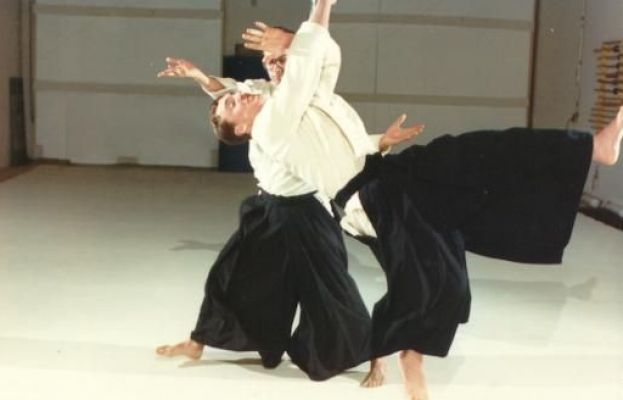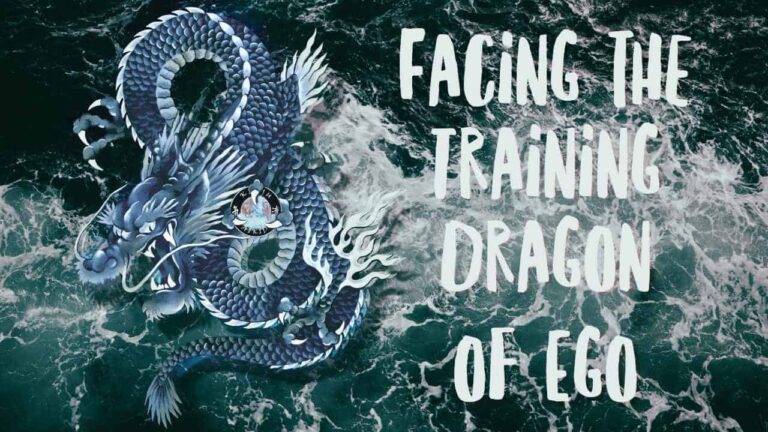Grit: Passion and Perseverance on Your Aikido Journey
What if the more important part of learning Aikido isn’t natural talent, athleticism, or a certain body type, but instead a long-term learning mindset that’s within the reach of every student?
This approach was discovered by Angela Duckworth, Ph.D., professor of psychology at the University of Pennsylvania, who began her career as an elementary school teacher. Through her research, she discovered the secret to high-level and consistent achievement and success is not talent. It’s grit – the blend of passion and perseverance.
Developing grit can lead to achievement in any area: as a parent, athlete, educator, business person, and Aikido student.
Read on to learn more about grit and its components of passion and perseverance, discover your current level of grit, and explore how these qualities can help you on your journey of learning Aikido… and through life.
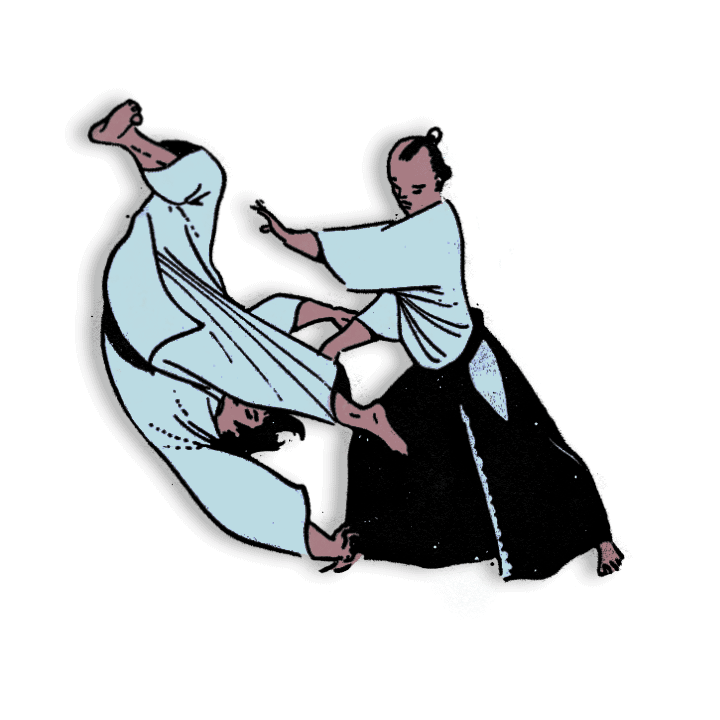
Grit: From Spelling Bee Champs to Navy Seals
Angela Duckworth, Ph.D., is the Christopher H. Browne Distinguished Professor of Psychology at the University of Pennsylvania, faculty co-director of the Penn-Wharton Behavior Change for Good Initiative, and faculty co-director of Wharton People Analytics.
Dr. Duckworth began her career as an elementary school teacher followed by a stint as a consultant with McKinsey and her entrance into the field of neuroscience and psychology.
Through research with Navy Seals, National Spelling Bee champions, cadets at West Point, and more, she discovered that success is based not on natural talent but rather on long-term focus and dedication to improvement.
She published the ideas in her 2016 book “Grit: The Power of Passion and Perseverance.”
What Is Grit? And How Does it Lead to Success?
When we look at successful people we admire, whether they’re actors, musicians, singers, professional athletes, or renowned experts in their academic fields, we see their accomplishments.
The win-loss record. The MVP awards. The Oscars. The Grammys. The TED talks. The ground-breaking research. The billion-dollar Internet companies.
It’s easy to assume that they started here — success right out of the gate.
But behind the curtain, behind the perfect YouTube video, behind the Super Bowl win, and the acceptance speech are hours and days and weeks and years and years of private unseen practice. Practice that is challenging, frustrating, and filled with mistakes.
It’s that diligence and effort over the long haul that translates to success.
As Dr. Duckworth explains from her research , “no matter the domain, the highly successful had a kind of ferocious determination that played out in two ways. First, these exemplars were unusually resilient and hardworking. Second, they knew in a very, very deep way what it was they wanted. They not only had determination, they had direction. It was this combination of passion and perseverance that made high achievers special. In a word, they had grit.”
Grit = Passion + Perseverance
Success comes from both components of grit: passion and perseverance. As Dr. Duckworth describes it, “Grit isn’t just working incredibly hard. That’s only part of it.”
She continues, “Grit is about working on something you care about so much that you’re willing to stay loyal to it.”
Let’s define these components according to Dr. Duckworth.
Passion: “Passion is a compass — that thing that takes you some time to build, tinker with and finally get right, and that then guides you on your long and winding road to where, ultimately, you want to be.”
Perseverance: “One form of perseverance is the daily discipline of trying to do things better than we did yesterday. So, after you’ve discovered and developed interest in a particular area [your passion], you must devote yourself to the sort of focused, full-hearted, challenge-exceeding-skill practice that leads to mastery.”
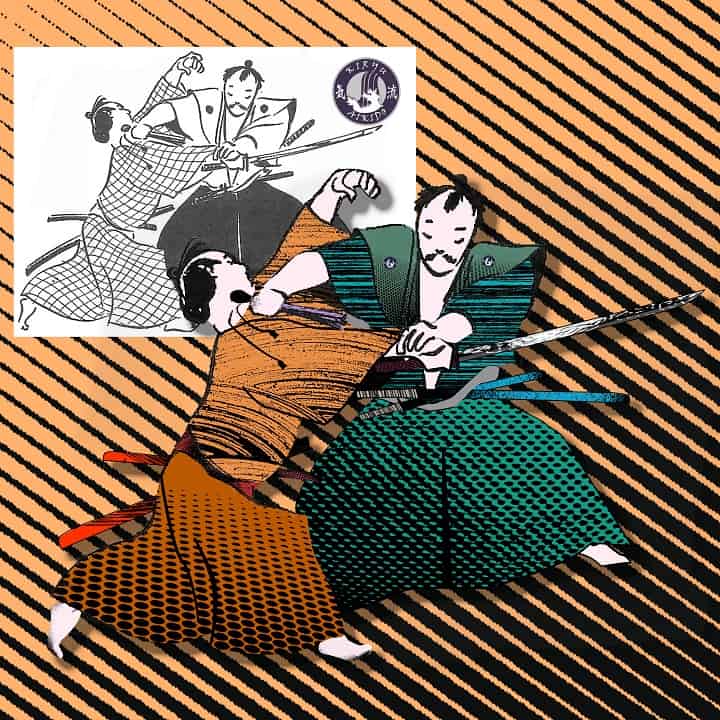
It’s important to clarify that we can have passion without erseverance or perseverance without passion. It’s the combination that leads to long-term, lifetime success.
As an example, passion without perseverance means we might take up a new hobby. For a while, we pursue it with obsessive focus. But after a time — whether that’s a few weeks or a year or two — we give it up and move on to the next new thing.
On the other end of the spectrum, perseverance without passion is doggedly pursuing an activity that we don’t enjoy intrinsically. Maybe we come from a family of doctors or lawyers. We’re expected to follow in the family footsteps, so we go to medical or law school. The more time we spend with it, the more we know it isn’t for us, but we keep going. Maybe we’re doing it because of other people’s expectations. Maybe it’s societal influence. While we may find a level of outward success with it, we don’t enjoy the process of learning and uncovering more layers the more we learn. We stick with it because we feel we don’t have a choice, not because we want to.
How Gritty Are You?
Dr. Duckworth developed the 10-question Grit Scale that tabulates current levels of passion and perseverance, which when combined, result in your level of grit.
For each question, answer as the person you are today – not the person you wish you were. (Note that your grit level can change over the years.)
| Circle the answer for each statement that applies closest to you | Not like me at all | Not much like me | Somewhat like me | Mostly like me | Very much like me |
|---|---|---|---|---|---|
| 1. New ideas and projects sometimes distract me from previous ones. | 5 | 4 | 3 | 2 | 1 |
| 2. Setbacks don’t discourage me. I don’t give up easily. | 1 | 2 | 3 | 4 | 5 |
| 3. I often set a goal but later choose to pursue a different one. | 5 | 4 | 3 | 2 | 1 |
| 4. I am a hard worker. | 1 | 2 | 3 | 4 | 5 |
| 5. I have difficulty maintaining my focus on projects that take more than a few months to complete. | 5 | 4 | 3 | 2 | 1 |
| 6. I finish whatever I begin. | 1 | 2 | 3 | 4 | 5 |
| 7. My interests change from year to year. | 5 | 4 | 3 | 2 | 1 |
| 8. I am diligent. I never give up. | 1 | 2 | 3 | 4 | 5 |
| 9. I have been obsessed with a certain idea or project for a short time but later lost interest. | 5 | 4 | 3 | 2 | 1 |
| 10. I have overcome setbacks to conquer an important challenge. | 1 | 2 | 3 | 4 | 5 |
Add up the boxes you circled and divide by 10. The maximum score is 5 (extremely gritty). The lowest possible score is 1 (not at all gritty).
The even-numbered questions calculate passion. The odd-numbered questions calculate perseverance.
What do you see? And do you see patterns or areas you’d like to improve?
You can take the quiz online for free:
Can You Grow Your Grit Level?
Absolutely!
As Dr. Duckworth explains it, “grit grows as we figure out our life philosophy, learn to dust ourselves off after rejection and disappointment, and learn to tell the difference between low-level goals that should be abandoned quickly and higher-level goals that demand more tenacity.”
In short, “we develop the capacity for long-term passion and perseverance as we get older.”
She describes four psychological assets that often develop, in a particular order, over the years. More life experience really can lead to greater grit.
Interest: The intrinsic enjoyment of enjoying the work is the start of developing a passion. While not every aspect of the work may be enjoyable, the endeavor overall is captivating.
Practice: This is trying today to do things better than we did yesterday. It’s a daily focus on improving weaknesses and improving strengths. Gritty practice is not complacent practice or just going through the motions.
Purpose: When the activity matters, you have the conviction you share it with others. Without purpose, it’s nearly impossible to sustain a passion over a lifetime.
Hope. Hope spans the entire arc of grit, and it’s that inner strength to rise to the occasion and keep going – even when we have doubt or struggle during a challenging period.
Deliberate Practice: How Grit Can Help You… In Aikido in Life
This dedication to deliberate practice is one of the key factors of grit that highly successful people use to improve over the long term.
This is so true In Aikido practice, both from the first time we bow onto the mat and as we continue to learn as a martial artist.
Here are a few tips for students at all levels.
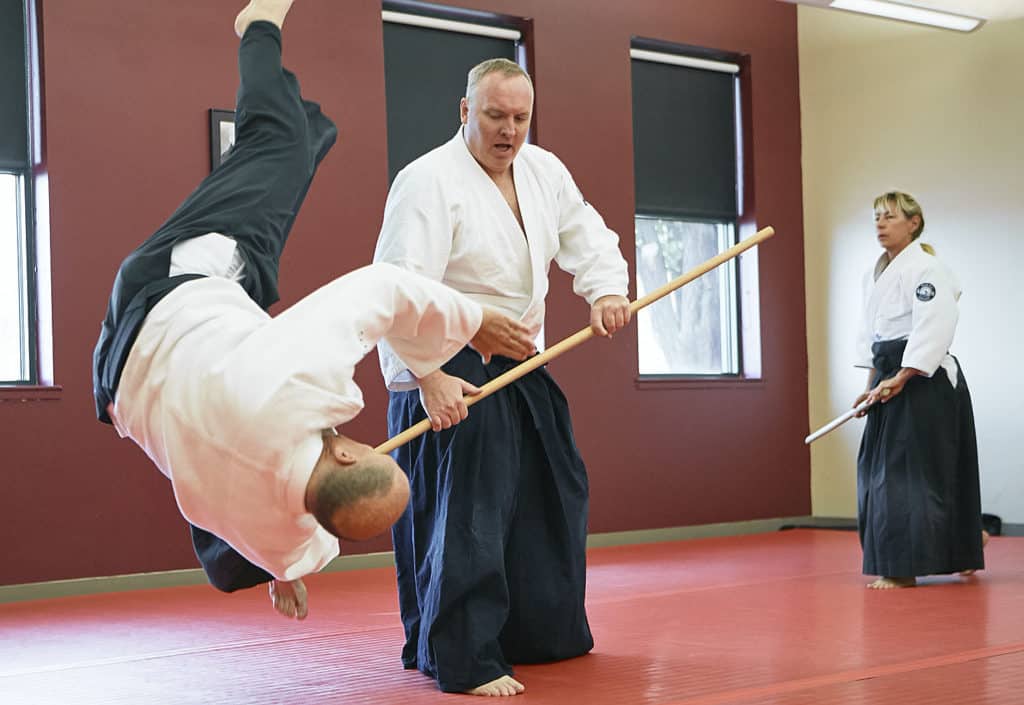
Here are a few tips for students at all levels.
New Students
When we first start our practice, it can be a little (or a lot) intimidating. We show up at the dojo for our first class as a complete beginner. A helpful fellow student shows us how to tie our belt and shows us how to bow onto the mat. So far so good.
Then the instructor demonstrates the first Tai No Henko. While it looks easy when the Sensei does it, getting our body to do the same basic movements is not easy. At all. In fact, it’s so frustrating.
“Wow,” begins our inner dialogue. “I’m no good at this. I hate looking stupid. I can’t do a simple technique, and look at those black belts over in the corner doing a really complex movement and they’re falling really hard. That’s scary. I’ll never be able to do that. I’m not cut out for Aikido.”
What happens next when they get home after that first practice?
They might say, “Aikido is really hard. Glad I tried it but it isn’t for me. I’m not going back.”
Or they might say, “Aikido is really hard. I have no idea what I’m doing, but I’ll keep going and see what happens. I can’t get any worse, that’s for sure.”
Their decision to return to another class – even though it is hard, even though they don’t understand it, even though they may be sore – is grit.
Even more true is the fact that they WILL get better. They will improve. They will develop the muscle memory, flexibility, and familiarity with the techniques. All they need to do is keep coming to class.
It’s an unfortunate truth that we think we should be good at Aikido from the very beginning. For some reason, we think that our challenges (which are 100% normal!) with seeing a movement but not being able to quickly translate that into our own bodies is a failure or a huge flaw that we can’t overcome.
But that’s a normal part of learning anything! A great example is when we learned how to walk. We pulled ourselves up, took a wobbly step, and fell down. Over and over. We didn’t start the inner dialogue of how unathletic we are, how we don’t want to look foolish, how other kids are getting so much faster than we are, how it’s not worth it – hey, you know, this walking thing? I’m just not cut out for it.
Luckily, we don’t say that! We pull ourselves up again, take another step. Again and again. And then, something clicks. We take two steps, then three. And pretty soon, we’re cruising all over the house.
When our dojo had a booth at a fitness fair several years ago, a lady stopped by and picked up a flyer.
“I want to be good at Aikido,” she said. “But I don’t want to get good at Aikido.” Translation: I want to magically be proficient at Aikido without practicing and the commitment to get there.
As new students, when we look at more advanced students, we have to remember that they didn’t start there. No, they started where we are today. They were confused, felt embarrassed, clumsy, and uncoordinated. The only difference between them and us is they continued to practice.
We see only their great technique and ukemi. What we don’t see is the hundreds or thousands of hours of practice to get there – practice that is imperfect, mistake-ridden, and often frustrating. But instead of being demoralizing, the practice is done with a positive and deliberate approach to improvement and continued learning.
Can you relate this to your Aikido practice?
Advanced Students
At a certain point, you’ll realize you’re no longer a beginner. You understand the Kihon – the basics – of Aikido: movement, balance, terminology, ukemi, and more.
You can do many techniques and your ability as Nage and Uke is solid.
What happens next paves the way for the next steps of your Aikido journey.
When most of the techniques are familiar, it can be easy to think “I know that one,” and do it the way you know how. But perhaps the Sensei is showing a different way to move, or a different ending, or has changed up another element. Maybe we’re attending a seminar and the host dojo and Sensei has a very different style.
Instead of seeing the difference and doing our best to try that, our muscle memory kicks in. Doing it a different way is hard! We have to consciously overcome that default movement.
It’s no longer comfortable, and we feel challenged – almost like a beginner again. We’re confused, struggling, frustrated, and then our ego can get in the way because we don’t want to look foolish.
It can be so tempting to stick with what we know, what we’re proficient at. It’s easier, it’s less risky, and we feel more confident.
The more years we train in Aikido, the more opportunities we have to deepen our understanding. But that’s not easy. It takes a conscious decision to open our minds, listen to what our Sensei is showing and teaching. It requires us to become comfortable with the discomfort of not-knowing and letting our ego accept the risk of imperfection as we continue to learn and grow.
After all, that’s perhaps the biggest joy of Aikido.
With steady practice and dedication, we’ll eventually test for our first-degree black belt. As they say, Shodan is really the first step in learning Aikido. All the practice leading to it prepared us to now practice at a deeper level and keep peeling away the onion to continue improving.
It’s up to us. Will we choose the path of having one year of experience 10 times, or using those 10 years to continue to grow and learn?
Steps to Build Grit into Your Practice
Dr. Duckworth shares the common requirements of creating deliberate practice.
In addition to our Aikido, we can use this approach throughout life, from studying in school, to our first job, as we develop our career, and create a well-lived life.
Deliberate practice includes:
- Set a clearly defined stretch goal. Identify a specific weakness. Focus on one narrow area to improve.
- Commit to and strive to accomplish the stretch goal.
- Make deliberate practice a habit. Do it at the same time, in the same place, every day.
- During practice, use full concentration and effort. Eliminate distractions.
- Seek immediate, informative feedback. Listen to and implement the instruction.
- Repeat with reflection and refinement.
- Once you’ve reached the first stretch goal, set another.
- Repeat.
According to Dr. Duckworth, “No matter their initial talent, performers in every domain improve through deliberate practice…. Trying to do things you can’t do yet, failing, and learning what to do differently is exactly how experts practice.”
Remember that feeling frustrated isn’t necessarily a sign you’re on the wrong track. Wanting to do better is one of the best traits to have during learning. Instead, change the way you interpret frustration or challenge. Learn to embrace it rather than fear or dread it.
Grit to Grow On
When we discover an interest that develops into a passion and we apply the long-term dedication of improvement, we’ve got grit.
No matter our level of grit today, we can consciously develop more over time.
For all of us, this is good news. Long-term success can be developed over time through a commitment to learning, seeing challenge as opportunity rather than failure, and nurturing a deep interest in an area that grows even stronger over time no matter how much experience we gain.
As our grit expands and strengthens as we mature, the benefits can extend well beyond completing college, getting a job, and starting a business. Grit can bring color to our life with meaning through continual growth and learning
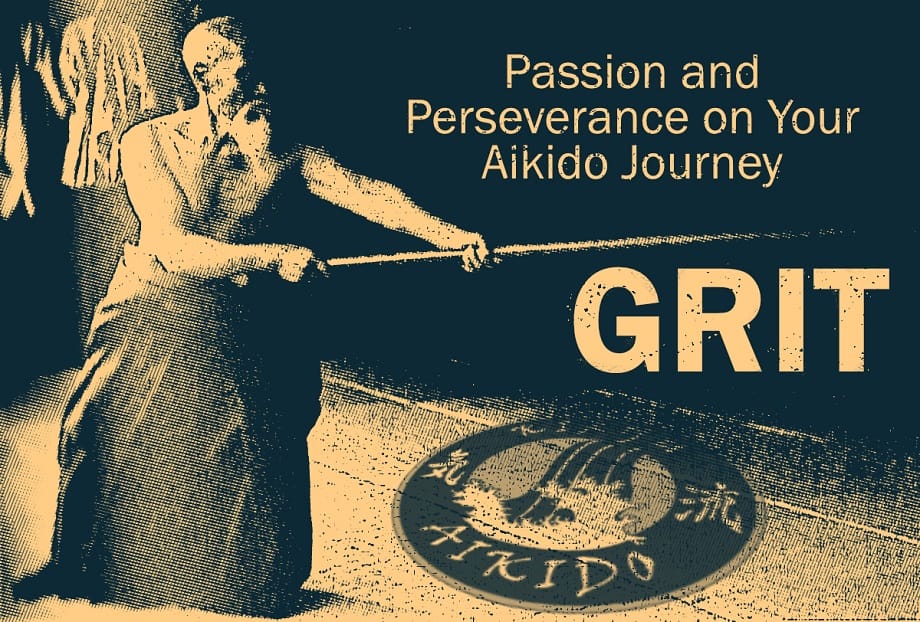
What’s Next for You?
What did you learn about grit, passion, and perseverance that will be helpful as you begin and and continue your Aikido journey? Let us know!
Be sure to check out the resources below for more inspiration as you continue to make progress toward your aspirations in Aikido, and life.
This article was originally written for and published by Laurus College, Nov. 2, 2020.
It is republished here with slight revisions for our audience.

